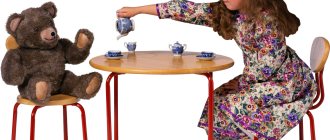The role and place of play in the educational process of preschool educational institutions in the context of the introduction of the Federal State Educational Standard
Nevertheless, play is an extremely important activity for a child’s development, since it shapes the qualities of a future worker. With a properly organized game, a future citizen is formed and the qualities necessary for social life are acquired.
The game teaches the child to correctly evaluate the behavior of people around him, forms the first elementary concept of official duty, develops the ability to behave in a certain way in society, to help the weak, to be organized and disciplined.
Play is also important for the physical development of a child. A good game creates a cheerful mood, increases the vital activity of the body, and promotes the development of movements. Creativity, initiative, and humor associated with children's games quite often leave a mark on a person's entire subsequent life and activity.
Children's games are characterized by the following features:
1. The game is a form of active reflection by the child of the people around him. 2. A distinctive feature of the game is the very method that the child uses in this activity. 3. The game, like any other human activity, has a social character, so it changes with changes in the historical conditions of people's lives. 4. Play is a form of creative reflection of reality by a child. 5. Play is the manipulation of knowledge, a means of clarification and enrichment, a way of exercise, and therefore the development of a child’s cognitive and moral abilities and strengths. 6. In its expanded form, the game is a collective activity. 7. By developing children in many ways, the game itself also changes and develops.
According to the Federal State Educational Standard
(clause 2.9)
“children’s development should be carried out in all five complementary educational areas.”
GAME is a specific children's activity, varied in its content, degree of independence of children, form of organization, game material, and each type has a certain impact on the development of the child and has many options. Therefore, through the game, various aspects of integration are realized, including the integration of the content and objectives of educational areas.
There are many classifications of games. In kindergarten we use the following classification of games:
Creative games;
Games with rules;
Folk games.
Each of the listed classes of games, in turn, is represented by types and subtypes.
Thus, the concept of “creative play”
covers role-playing games, dramatization games, construction games. The content of creative games is invented by the children themselves. Freedom, independence, self-organization and creativity of children in this group are especially fully manifested. Various life experiences are not copied, they are processed by children, some of them are replaced by others, etc.
The concept and essence of the game. Theory of play activity in domestic pedagogy and psychology
A wide, immediately inaccessible circle of reality can be mastered by a child only in play, in a playful form. This process of overcoming the past world through play actions in this world contains both play consciousness and play ignorance.
Play is a creative activity, and like any real creativity, it cannot do without intuition.
In the game, all aspects of a child’s personality are formed, significant changes occur in his psyche, which prepare him for the transition to a new, higher stage of development. This explains the enormous educational potential of play, which psychologists consider the leading activity of preschool children.
A special place is occupied by games created by children themselves - they are called creative or role-playing games. In these games, preschoolers role-play everything that they see around them in the lives and activities of adults. Creative play most of all shapes a child’s personality and is therefore an important means of education.
The game is a reflection of life. Everything here is “as if”, “make-believe”, but in this conditional environment created by the child’s imagination, there is a lot of reality: the actions of the players are always real, their feelings and experiences are real, sincere. The child knows that the doll and the bear are just toys, but he loves them as if they were alive, he understands that he is not a “righteous” pilot or sailor, but feels like a brave pilot, a brave sailor who is not afraid of danger, truly proud of his victory.
Imitating adults in play is associated with the work of the imagination. The child does not copy reality, but combines various impressions of life with personal experience.
Children's creativity is manifested in coming up with an idea for a game and finding means to implement it. How much ingenuity is needed to decide what trip to take, what ship or plane to build, what equipment to prepare! In the game, children simultaneously act as playwrights, prop makers, decorators and actors. However, they do not nurture your idea and do not prepare to play the role of actors for a long time. They play for themselves, expressing their own dreams and desires, thoughts and feelings that they have at the moment.
Therefore, the game is always improvisation.
Play is an independent activity in which children first interact with peers. They are connected by a common goal, joint efforts to achieve it, common interests and experience.
Children choose the game themselves and organize it. But at the same time, in no other activity are there such strict rules, such conditioning of behavior as here. Therefore, the game teaches children to subordinate their actions and thoughts to a specific goal, and helps to develop sense of purpose.
In the game, the child begins to feel like a member of the team, and fairly evaluates the actions and actions of his comrades and his own. The teacher’s task is to direct the players’ attention to goals that evoke common feelings and actions and contribute to the establishment of relationships between children based on friendship, justice and mutual responsibility.
The first position, which determines the nature of the game, states that the motives of the game lie in various experiences that are significant aspects of reality for the player. A game, like any other human activity that is not a game, is motivated by an attitude towards goals that are significant to a person.
In the game, only those actions are performed whose goals are significant for a person due to their own internal content. This is the main feature of gaming activity and this is its main fascination.
The second - characteristic - feature of the game is that the game action implements the diverse motives of human action and, realizing emerging goals, is not tied to the means or methods of action by which these actions are carried out in a non-game practical plan.
Play is an activity in which the contradiction between the rapid growth of the child’s needs, which determines the motivation of his activity, and the limitation of his operational capabilities is resolved. Play is a form of realizing the child’s needs and requirements within the limits of his capabilities.
The next, outwardly most striking distinctive feature of play, which actually follows from the above-mentioned internal features of play activity, is the opportunity, which is a necessity for the child, within the limits determined by the meaning of the game, to replace objects that function in the corresponding non-play practical action with others that can serve for a play action (stick - horse, chair - car, etc.). The ability to creatively change reality is formed only in the game. This ability is the main value of the game.
Does this mean that playing in an imaginary situation is an escape from reality? Yes and no. In the game there is an escape from reality, but there is also an intrusion into it. Thus, there is no escape, no escape from reality into a seemingly special, imaginary, fictitious, unreal world. Everything that the play lives in and that is embodied in the action is taken from reality. The play goes beyond the situation, abstracts from some aspects of reality in order to reveal others more deeply.
The importance of play for the development of the personality of a preschool child
Long before play became a subject of scientific research, it was widely used as one of the most important means of raising children. The development of education as a social function is centuries old, as is the use of games as a pedagogical tool. In different education systems, the game has a different role, but there is not a single system in which the game is not given a place in one way or another.
Various functions are attributed to the game, both purely pedagogical and educational, therefore it is necessary to more accurately determine the characteristics of the play activity of preschoolers, its impact on the development of the child and find the place of this activity in the general system of pedagogical work of children's institutions.
It is necessary to more accurately determine those aspects of the child’s mental development and personality formation that develop primarily in play or experience only limited influence in other activities.
It is very difficult to study the importance of play for mental development and personality formation. Here, a pure experiment is impossible, because it is impossible to remove play activities from the lives of children and see how the development process occurs in this case.
The main thing is the importance of play for the child’s motivation and the area of his needs. Following the work of D. B. Elkonin, the problem of motives and needs comes to the fore.
The transformation of play during the transition from preschool to preschool childhood is based on the expansion of the range of human objects, the mastery of which is now the child’s task, and the world that he perceives in the course of his further mental development. It is based on the child’s “discovery” of a new world, the world of adults with their activities, their functions, their relationships. At the border of the transition from object-based to role-playing play, the child knows neither the social relations of adults, nor social functions, nor the social meaning of their activities. He acts in the direction of his desire, puts himself objectively in the position of an adult, and an emotional-actual orientation arises in relation to adults and the meaning of their activities. Here the intellect follows the emotional-factual experience. Play functions as an activity that is most closely related to the child's needs. There is a primary emotional and functional orientation in the meaning of human activity, there is an awareness of one’s limited place in the system of adult relationships and the need to be an adult. The importance of play is not limited to the child’s development of new motives for activity and related tasks. The important thing is that a new psychological form of motives arises in the game. One can hypothetically imagine that in the game there is a transition from immediate desires to motives in the form of generalized intentions that are on the verge of consciousness.
Before talking about the development of mental actions during the game, it is necessary to list the main stages that the formation of each mental action and related concepts must go through:
- the stage of formation of action on material objects or their material substitute models;
- the stage of forming the same action in the form of loud speech;
- the stage of formation of the mental action itself.
Looking at a child's actions in play, it is easy to notice that he is already acting with the meanings of objects, but still relies on their material substitutes - toys. If at the initial stages of development a substitute object and a relatively developed action with it are required, then at a later stage of the development of the game the object acts through words - naming as a designation of a thing, and action as abbreviated and generalized gestures accompanied by speech. Thus, play actions are intermediate in nature; they gradually acquire the character of mental actions with the meanings of objects performed in external actions.
The path of development to actions in the mind with meanings divorced from objects is simultaneously the emergence of prerequisites for the formation of imagination. A game is an activity in which the prerequisites are formed for the transition of mental actions to a new, higher level - mental actions based on language. The functional development of play actions permeates ontogenetic development and forms the zone of subsequent development of mental actions.
In play activities, a significant reorganization of the child’s behavior occurs - it becomes voluntary. Voluntary behavior refers to behavior that is carried out in accordance with an image and is controlled by comparison with this image as a scene.
A. Zaporozhets was the first to point out that the nature of the movements performed by a child in a game and in a direct task differs significantly. He also noted that the structure and organization of movements change during development. It clearly separates the preparation phase and the execution phase.
The effectiveness of the movement, as well as its organization, largely depends on the structural position of the movement in the implementation of the role played by the child.
The yoke is the first form of activity available to the student and involves conscious learning and honing of new actions.
Z. V. Manuleiko reveals the question of the psychological mechanism of the game. Based on her work, we can say that great importance is attached to the motivation of activity in the psychological mechanism of play. The performance of an emotionally attractive role has a stimulating effect on the performance of actions in which this role finds its expression.
However, mere indication of motives is not enough. It is necessary to find a mental mechanism by which motives can have such an influence. When playing a role, the pattern of behavior contained in the role simultaneously becomes the standard with which the child compares his behavior and controls it. A child performs two functions in play; on the one hand, he plays his role, and on the other, he controls his behavior. Voluntary behavior is characterized not only by the presence of a pattern, but also by the presence of control over the implementation of this pattern. When playing a role, a kind of split occurs, that is, “reflection.” But this is not yet conscious control, because the control function is still weak and often needs support from the situation, from the participants in the game. This is the weakness of the emergent function, but the importance of the game is that this function is emergent here. Therefore, the game can be considered as a school of volitional behavior.
Play is important for forming a friendly team of children, for developing independence, for developing a positive attitude towards work, and much more. The basis of all these educational effects is the influence that play has on the mental development of the child, on the formation of his personality.








